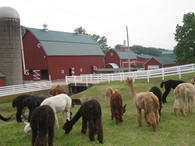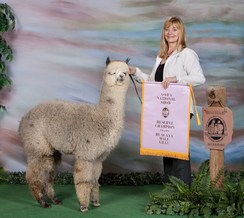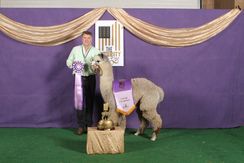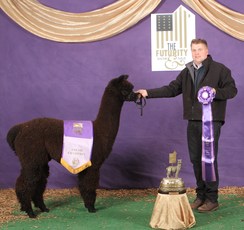About Alpacas
The Alpacas
Alpacas were a cherished treasure of the ancient Incan civilization and played a central role in the Incan culture that was located on the high Andean Plateau and mountains of South America. Alpacas were first imported to the United States in 1984. Alpacas are now being successfully raised and enjoyed throughout North America and abroad. There are two types of alpacas - the Huacaya and the Suri. The lifespan of the alpaca is about 20 years and gestation is 11.5 months. Alpacas eat grasses and chew a cud. Adult alpacas are about 36" tall at the withers and generally weigh between 100 and 200 pounds. They are gentle and easy to handle. Alpacas don't have incisors, horns, hooves or claws. Clean-up is easy since alpacas deposit droppings in only a few places in the paddock. They require minimal fencing and can be pastured at 5 to 10 per acre.
Alpacas produce one of the world's finest and most luxurious natural fibers. It is clipped from the animal without causing it injury. Soft as cashmere and warmer, lighter and stronger than wool, it comes in more colors than any other fiber producing animal (approximately 22 basic colors with many variations and blends).This cashmere-like fleece, once reserved for Incan royalty, is now enjoyed by spinners and weavers around the world.
Alpaca Facts
Luxury Fleece
When all is said and done, it is the alpaca's fiber that makes this animal such a popular and sound investment. Lighter, softer, warmer and more durable than sheep's wool, this luxuriously soft hollow fiber is highly sought-after around the world for fine knitted and woven clothing and blankets. Baby blankets made from alpaca often become family heirlooms, passed on from one generation to the next. The low micron count of each fiber ranges from 20 to 36.
In the US, alpacas are not slaughtered for their fleece. We shear them annually in the spring to help them be cooler during the summer months. The fiber is then processed into yarn, as well as knitted and woven garments. One of the wonderful things about raising alpacas as livestock is that they have a long and healthy life in our care.
Combined with the lack of scratchy guard hairs, the fineness of the fiber creates finished products that can easily be worn next to the skin by most people without the itchy feeling of wool. The average adult alpaca produces 5-10 pounds of fiber with each shearing. It comes in 22 natural colors, ranging from white to black, with every imaginable rich shade of brown and silver in between. The lustrous texture of alpaca fiber makes it popular with hand spinners, knitters and weavers. The commercial industry is expanding every year as the American alpaca population grows. Soon there will be enough fiber produced in the United States to support larger commercial mills, and the alpaca fiber industry will begin to soar.
Alpaca Lifestyle
The joy, ease of care and potential profitability of raising alpacas has attracted people from many walks of life to become breeders. For some, alpacas are a primary source of income, for others a part-time business venture, but a source of pleasure for both. Young couples with children can enjoy the benefits of owning and caring for alpacas as a rewarding family experience. People who have raised their kids and are seeking a business and lifestyle to enjoy as they approach retirement are often owners. Ultimately, whether making the switch from a fast-paced, corporate way of life, or adding alpacas to an already established rural setting, breeding these unique, gentle animals can provide both income and pleasure, all included in a peaceful, stress-free lifestyle.
This lifestyle is made possible since alpacas can be raised on relatively small acreage and they are clean, safe, quiet, intelligent and disease resistant. Alpacas have soft padded feet, are gentle on the land and can be easily transported.
There are also plenty of family-oriented alpaca events around the country, including local and state fairs, alpaca farm open houses and auctions, and larger shows hosted by alpaca organizations, the largest and most impressive being the annual Alpaca conference and show presented by AOBA. Some breeders also choose to get involved in selling products made from alpaca fiber as a hobby or an additional home-based business venture. The spinning and weaving of fiber is a skill that can lead to profits.
Alpacas have brought impressive financial returns to families all across America, but it's the fun and hands-on nature of this lifestyle that has really captivated people searching for a simpler and more rewarding way of life. Even if you don't have the land and are committed to a full-time career, you can still begin your alpaca adventure by purchasing and boarding at a nearby alpaca farm or ranch. A retired doctor who is now a full-time alpaca breeder had this to say, "I would rather raise alpacas than anything I've ever done. Breeding alpacas is a labor of love and can be very profitable."
Environmentally Friendly Alpacas
Alpacas have been domesticated for more than 5,000 years. They are one of Mother Nature's favorite farm animals. They are sensitive to their environment in every respect. The following physical attributes allow alpacas to maintain their harmony with our Mother Earth.
Alpacas were a cherished treasure of the ancient Incan civilization and played a central role in the Incan culture that was located on the high Andean Plateau and mountains of South America. Alpacas were first imported to the United States in 1984. Alpacas are now being successfully raised and enjoyed throughout North America and abroad. There are two types of alpacas - the Huacaya and the Suri. The lifespan of the alpaca is about 20 years and gestation is 11.5 months. Alpacas eat grasses and chew a cud. Adult alpacas are about 36" tall at the withers and generally weigh between 100 and 200 pounds. They are gentle and easy to handle. Alpacas don't have incisors, horns, hooves or claws. Clean-up is easy since alpacas deposit droppings in only a few places in the paddock. They require minimal fencing and can be pastured at 5 to 10 per acre.
Alpacas produce one of the world's finest and most luxurious natural fibers. It is clipped from the animal without causing it injury. Soft as cashmere and warmer, lighter and stronger than wool, it comes in more colors than any other fiber producing animal (approximately 22 basic colors with many variations and blends).This cashmere-like fleece, once reserved for Incan royalty, is now enjoyed by spinners and weavers around the world.
Alpaca Facts
- Life Span: 15 - 25 years
- Average Gestation is 335 days
- Single births.
- Highly interactive and entertaining.
- Highly intelligent.
- Colors: 22 basic colors that may blend into beautiful variations, 250 shades.
- Harvest approximately 6-10 pounds of fiber per year.
- Alpacas eat about as much as a medium sized dog.
- Birth: Birth weight is usually around 15 to 19 lbs. Babies can often stand and nurse within 30 minutes to one hour.
- Infant mortality is very low.
- Average Weight: 100 to 175 lbs. or about 1/3 the size of the llama.
- Average Adult Height: 32"- 37" at the withers.
- Financial Investment: Alpacas offer solid financial returns, market is strong in the USA and returns are around 15 to 38% (AOBA's Investment Brochure)
- Alpacas dung in one or two areas in their pasture. This makes for easy clean up.
- Adaptable to many environments.
Luxury Fleece
When all is said and done, it is the alpaca's fiber that makes this animal such a popular and sound investment. Lighter, softer, warmer and more durable than sheep's wool, this luxuriously soft hollow fiber is highly sought-after around the world for fine knitted and woven clothing and blankets. Baby blankets made from alpaca often become family heirlooms, passed on from one generation to the next. The low micron count of each fiber ranges from 20 to 36.
In the US, alpacas are not slaughtered for their fleece. We shear them annually in the spring to help them be cooler during the summer months. The fiber is then processed into yarn, as well as knitted and woven garments. One of the wonderful things about raising alpacas as livestock is that they have a long and healthy life in our care.
Combined with the lack of scratchy guard hairs, the fineness of the fiber creates finished products that can easily be worn next to the skin by most people without the itchy feeling of wool. The average adult alpaca produces 5-10 pounds of fiber with each shearing. It comes in 22 natural colors, ranging from white to black, with every imaginable rich shade of brown and silver in between. The lustrous texture of alpaca fiber makes it popular with hand spinners, knitters and weavers. The commercial industry is expanding every year as the American alpaca population grows. Soon there will be enough fiber produced in the United States to support larger commercial mills, and the alpaca fiber industry will begin to soar.
Alpaca Lifestyle
The joy, ease of care and potential profitability of raising alpacas has attracted people from many walks of life to become breeders. For some, alpacas are a primary source of income, for others a part-time business venture, but a source of pleasure for both. Young couples with children can enjoy the benefits of owning and caring for alpacas as a rewarding family experience. People who have raised their kids and are seeking a business and lifestyle to enjoy as they approach retirement are often owners. Ultimately, whether making the switch from a fast-paced, corporate way of life, or adding alpacas to an already established rural setting, breeding these unique, gentle animals can provide both income and pleasure, all included in a peaceful, stress-free lifestyle.
This lifestyle is made possible since alpacas can be raised on relatively small acreage and they are clean, safe, quiet, intelligent and disease resistant. Alpacas have soft padded feet, are gentle on the land and can be easily transported.
There are also plenty of family-oriented alpaca events around the country, including local and state fairs, alpaca farm open houses and auctions, and larger shows hosted by alpaca organizations, the largest and most impressive being the annual Alpaca conference and show presented by AOBA. Some breeders also choose to get involved in selling products made from alpaca fiber as a hobby or an additional home-based business venture. The spinning and weaving of fiber is a skill that can lead to profits.
Alpacas have brought impressive financial returns to families all across America, but it's the fun and hands-on nature of this lifestyle that has really captivated people searching for a simpler and more rewarding way of life. Even if you don't have the land and are committed to a full-time career, you can still begin your alpaca adventure by purchasing and boarding at a nearby alpaca farm or ranch. A retired doctor who is now a full-time alpaca breeder had this to say, "I would rather raise alpacas than anything I've ever done. Breeding alpacas is a labor of love and can be very profitable."
Environmentally Friendly Alpacas
Alpacas have been domesticated for more than 5,000 years. They are one of Mother Nature's favorite farm animals. They are sensitive to their environment in every respect. The following physical attributes allow alpacas to maintain their harmony with our Mother Earth.
- The alpaca's feet are padded and they leave even the most delicate terrain undamaged as it browses on native grasses.
- The alpaca is a modified ruminant with a three-compartment stomach. It converts grass and hay to energy very efficiently, eating less than other farm animals.
- Its camelid ancestry allows the alpaca to thrive without consuming very much water, although an abundant, fresh water supply is necessary.
- The alpaca does not usually eat or destroy trees, preferring tender grasses, which it does not pull up by the roots.
- South American Indians use alpaca dung for fuel and gardeners find the alpaca's rich fertilizer perfect for growing fruits and vegetables.
- A herd of alpacas consolidates its feces in one or two spots in the pasture, thereby controlling the spread of parasites, and making it easy to collect and compost for fertilizer.
- An alpaca produces enough fleece each year to create several soft, warm sweaters for its owners comfort. This is the alpaca's way of contributing to community energy conservation efforts.
Monday, May 14, 2012



